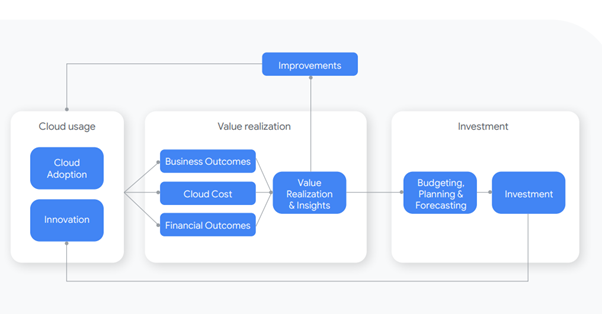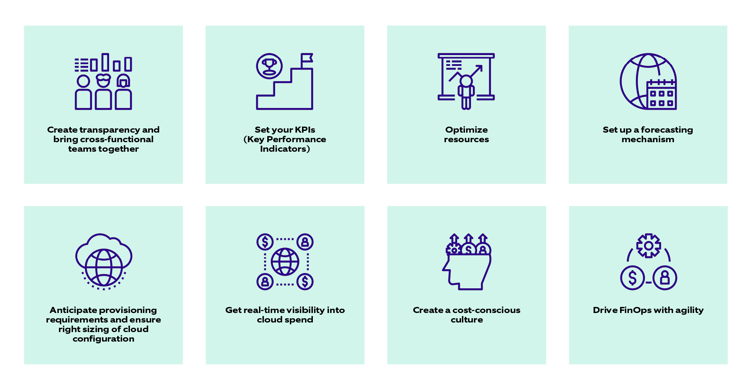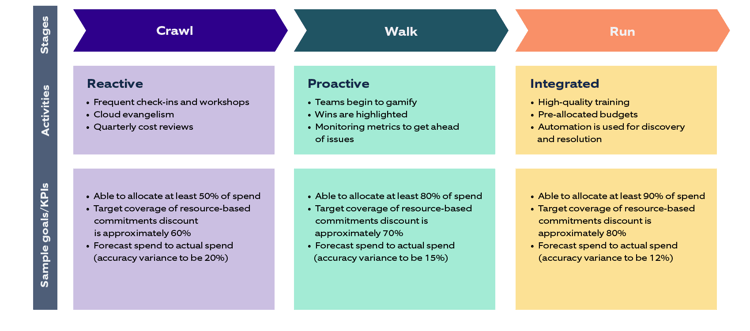This is the second blog of our ‘101 of FinOps’ series. In the first blog, we outlined the basics of FinOps, why organizations should embrace it, and how to kickstart the journey towards cloud cost optimization.
With ever-evolving business priorities, CIOs look forward to remaining innovative, scalable, and resilient. This has made cloud adoption an integral part of the digital transformation journey undertaken by organizations. However, it does come with challenges. One of the most critical ones is to manage the spiraling cloud costs. If we go by Flexera’s 2022 State of the Cloud Report, organizations waste approximately 32% of their cloud spend on average.
But how? Cloud pricing can be incredibly complex and difficult to understand, especially with thousands of different SKUs, various dynamic pricing models, and various discount plans offered by several cloud service providers in the market. Other factors that add to the complexities include constant changes in pricing models, extreme granularity in billing, and lack of standardization among different cloud service providers.

Figure 1: As illustrated in Google Cloud’s whitepaper
Getting started with FinOps on GCP
Therefore, it has become essential to execute cloud cost management and optimization, in short, FinOps, right from the initial stages (migration, discovery, and POCs) to production, to minimize costs and maximize ROI on the cloud.
To begin, a centralized FinOps team/individual backed by senior leadership can help drive a cultural shift within the organization. With representation from various domains such as engineering, ops, infrastructure, Cloud CoE (Centre of Excellence), finance/procurement, executive, and business/product owner, your FinOps team can build communication channels and share knowledge of the cloud costing model as well as FinOps principles.
You will also be required to develop cloud cost reporting or monitoring dashboards, drive cost accountability within teams and create transparency across the organization. All this can be done by:
- Developing uniform cost allocation
- Implementing a well thought tagging strategy
- Following show back and chargeback processes
- Developing benchmarks to gamify cost and value generation, and
- Finalizing a set of business metrics such as accurate budgets, accurate forecasts, unit cost economics, discount/reservation coverage, percentage of untagged resources, and the efficiency opportunity that the cloud cost can be measured against.
Leading practices of optimizing cloud spend with Cloud FinOps
Listed below are the best practices we recommend you to follow to make the most out of your cloud and streamline your cloud costs.
 Figure 2: Best FinOps practices to optimize cloud spend
Figure 2: Best FinOps practices to optimize cloud spend
1. Create transparency and bring cross-functional teams together
One of the most important roles of FinOps practitioners is to bring together Finance, Engineering, CloudOps, and IT professionals so that they can collaborate and work efficiently towards a common objective of reducing cloud spend. Set up a cadence of regular meetings to track progress on usage & cost data. You must also define a common vocabulary to develop a better understanding between the teams.2. Set your KPIs (Key Performance Indicators)
FinOps heavily rely on KPIs as they help establish measurable benchmarks and metrics to monitor cloud resources as well as their consumption. Hence, you must start by setting up KPIs, and some of the most common ones are listed below as:
- Variance % of forecast v/s actual bill
- Total % of tag coverage
- Average price per hour of computing
- Unit cost (spend divided by a business metric)
- Usage on weekends vs. weekdays
- Committed Use Discount coverage
- RI (Reserved Instance) Coverage
You can find a comprehensive list of FinOps KPIs here.
3. Optimize resources
Once you know how much your organization is spending on the cloud, you need to thoroughly plan and do a detailed cost-benefit analysis to understand where and how the money is being spent. You can initiate this by mapping out current resources and chalking out an estimate of what will be the requirement for each service for an entire year.
Consider this scenario: You discover that over the last year, your company spent $5 million on cloud usage. The estimated budget was $3.5 million. Your team acknowledges that the organization has overspent but does not know where and why.
Now you can use FinOps tools to get a breakdown of the cloud cost usage across each department and evaluate the ROI of the cloud assets. This will further help balance the cloud costs by eliminating any excess costs incurred.
4. Set up a forecasting mechanism
Develop and implement a robust forecasting mechanism for 3 - 36 months. You can leverage readily available cloud cost optimization tools for more accurate results. FinOps-certified cloud cost management tools can help avoid surprises with cloud spending and optimize costs. These tools offer a myriad of features such as:
- Providing financial visibility and understanding of cloud costs
- Helping ensure accurate cost allocation so chargeback and show back is not a challenge
- Benchmarking so that you can track progress and know how the teams are performing in terms of optimization, performance, as well as quality
- Helping to forecast spending accurately so you can create a budget and avoid unexpected cost spikes
- Automating resource tagging efforts
- Detecting anomalies automatically and notifying the spikes in cloud spend
5. Anticipate provisioning requirements and ensure right-sizing of cloud configuration
Once in the cloud, you must never overprovision when deploying new resources. You can instead rely on autoscaling/dimming, serverless offerings, and the elastic nature of the cloud to dynamically and quickly respond to the changes in demand. You must also keep a check on the currently running instances as it is often observed that instances run long even after their need has ended, adding to the cloud bill.
6. Get real-time visibility into cloud spend
To make the best of FinOps, you require real-time visibility into your cloud usage to be able to make well-informed decisions. The report must provide insights into in-depth cost allocation, chargeback, show back, cost forecasting, benchmarking, trending, and variance analysis.
7. Create a cost-conscious culture
Migrating to the cloud is as much a cultural change as it is a technology transformation. A key aspect of FinOps is to drive everyone to take accountability for their costs. This will help make cloud users responsible for their spend and empower them to optimize it. You must strive to create a cost-conscious cloud culture where teams are focused on innovating and boosting performance, and at the same time are aware of opportunities in optimizing cloud cost.
8. Drive FinOps with agility
FinOps is successful when it is carried out in an agile manner. This means you must follow an iterative approach—a commitment to continuous improvement and automation. For instance, you must drive agile processes for budgeting and planning within IT by promoting iterative budget allocation, IT spending, and forecasting. You can also drive continuous improvement by sharing cost-efficient, successful architectural patterns widely amongst your employees. Furthermore, you can define rules on how a FinOps process should be automated and automate configuration through policy as code.
Different stages of FinOps journey that you must follow: By adopting a FinOps culture, you can reap several benefits—the most obvious one being proactively managing cloud costs efficiently. You will also notice reduced resource waste; you can make the most of the resources with techniques like automatic scaling and load balancing. With a well-crafted strategy, you can also align accountability to cloud users, build confidence around budgets and forecasts, as well as ensure smooth performance without increasing your budget.
By adopting a FinOps culture, you can reap several benefits—the most obvious one being proactively managing cloud costs efficiently. You will also notice reduced resource waste; you can make the most of the resources with techniques like automatic scaling and load balancing. With a well-crafted strategy, you can also align accountability to cloud users, build confidence around budgets and forecasts, as well as ensure smooth performance without increasing your budget.
What Nagarro brings to the table?
With hands-on experience in Cloud Cost Management, Nagarro can help you optimize and gain complete control over your cloud costs.
Our dedicated discipline of Cloud FinOps is well-equipped with a team of Certified FinOps Practitioners to help businesses start their FinOps journey. You can contact us today by clicking here.






